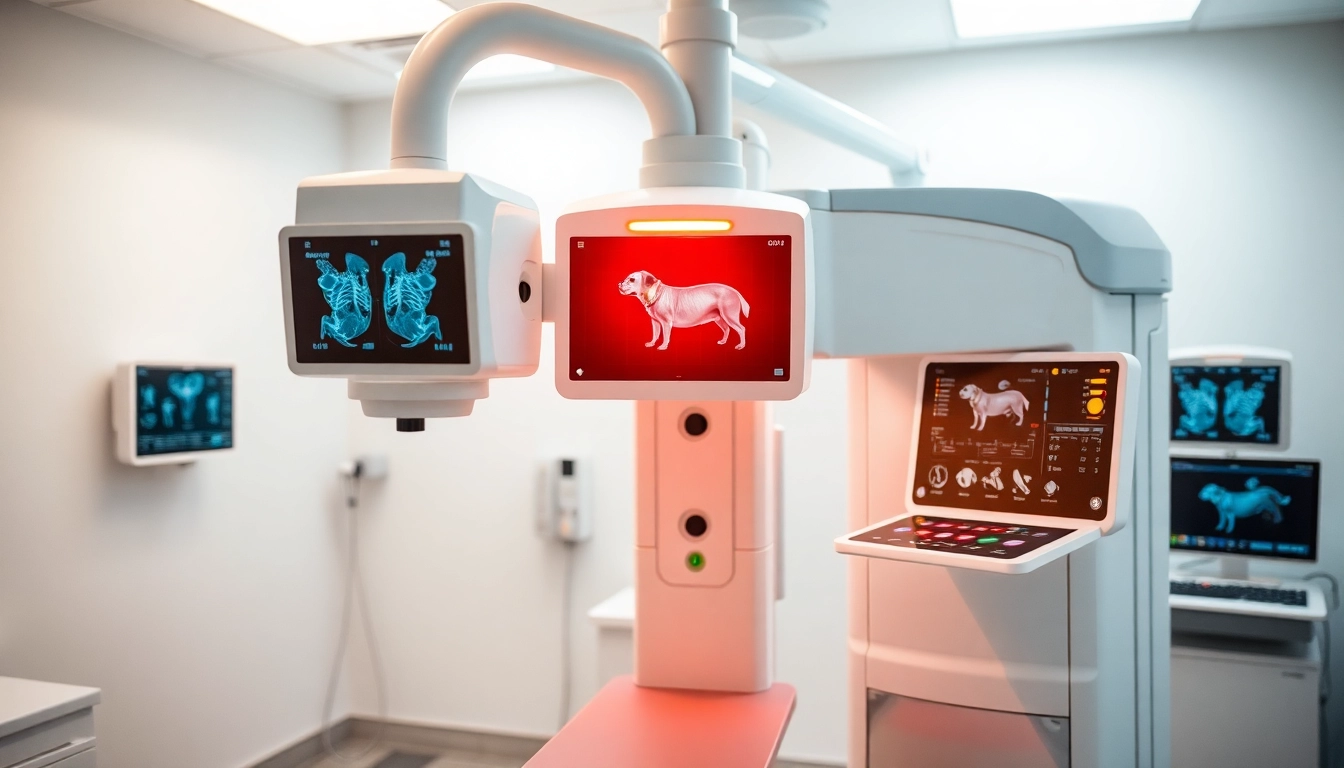Understanding the Veterinary X-Ray System
What is a Veterinary X-Ray System?
A veterinary x-ray system is a specialized imaging technology that enables veterinarians to diagnose and evaluate the health conditions of animals through non-invasive imaging techniques. These systems employ advanced radiographic technology to produce detailed images of various body structures, such as bones, organs, and tissues, facilitating precise diagnostics and treatment planning. Unlike traditional x-ray systems used in human medicine, veterinary x-ray systems are tailored to accommodate the anatomical diversity of different animal species, from household pets like dogs and cats to larger animals such as horses and livestock.
Key Features of Modern Systems
Modern veterinary x-ray systems are equipped with several advanced features that enhance their functionality and usability. Key features include:
- Digital Imaging: Most contemporary systems utilize digital radiography (DR), allowing instantaneous image capture and high-resolution output.
- Portability: Portable x-ray units enable veterinarians to conduct imaging in various settings, including on-site visits or field settings, improving patient access to care.
- Image Processing Software: Advanced software applications facilitate manipulation of x-ray images for improved visualization, diagnosis, and sharing with clients.
- Automatic Calibration: Many systems come with built-in calibration tools that ensure consistent image quality and accuracy, reducing human error.
- Low Radiation Exposure: Newer models incorporate features designed to minimize radiation exposure for both animals and veterinary staff.
Benefits for Veterinarians and Pet Owners
The implementation of a veterinary x-ray system offers numerous benefits for veterinarians and pet owners alike. For veterinarians, rapid and accurate imaging enables more effective diagnosis, resulting in timely treatment and improved patient outcomes. For pet owners, quick access to diagnostic results alleviates anxiety and facilitates informed decision-making regarding their pet’s health care. Additionally, effective imaging can also help in monitoring the progression of conditions, ensuring that treatments are effective and facilitating adjustments as needed.
Choosing the Right Veterinary X-Ray System
Factors to Consider When Purchasing
When selecting a veterinary x-ray system, several factors deserve careful consideration. These include:
- Type of Imaging Required: Determine whether your practice primarily requires standard x-ray imaging or advanced imaging options like dental radiography or ultrasound.
- Volume of Use: Assess how frequently x-ray services will be utilized to ensure that the system can handle your practice’s workload.
- Features and Specifications: Evaluate the specific features that are important for your practice, such as image resolution, software options, and portability.
- Integration with Existing Systems: Consider whether the new x-ray system will be compatible with your existing practice management software and other imaging equipment.
- Vendor Support and Warranty: Investigate the level of customer support offered by the vendor, including warranty terms and available training resources.
Comparing Different Brands and Models
To make an informed purchase, it’s essential to compare various brands and models of veterinary x-ray systems in the market. Look for key performance indicators such as user reviews, reliability, ease of use, and after-sales service. Top brands often provide detailed product specifications and performance metrics, which can help to differentiate models. Additionally, attending veterinary trade shows can provide insights into the latest advancements and allow hands-on comparisons of different systems.
Budgeting for Your Veterinary X-Ray System
Budgeting for a veterinary x-ray system encompasses more than just the initial purchase price. Practices should account for installation costs, ongoing maintenance, software upgrades, and potential training expenses. Additionally, evaluate financing options or leasing plans offered by vendors that may make the acquisition more financially feasible. By carefully analyzing total cost ownership, veterinary practices can make sound financial decisions that align with their long-term growth and technology needs.
Best Practices for Operating a Veterinary X-Ray System
Proper Training and Certifications
To operate a veterinary x-ray system effectively, veterinary technicians and veterinarians must undergo proper training and certification. Many states require that personnel handling x-ray equipment have specific credentials or follow guidelines established by veterinary regulatory bodies. Continuous education in operating the equipment, understanding radiation safety protocols, and recognizing the importance of quality images is critical to maintaining high standards within a practice.
Maintaining Equipment for Optimal Performance
Regular maintenance of your veterinary x-ray system is essential for ensuring optimal performance and longevity. This involves periodic servicing of the equipment, including cleaning, calibrating, and checking for wear or damage. Establish a schedule for routine checks based on the manufacturer’s recommendations and that takes into account the frequency of use in your practice. Engaging trained technicians for maintenance and repairs can prevent costly downtimes and ensure the unit operates safely and effectively.
Safety Protocols for Animals and Staff
Implementing strict safety protocols is essential within any veterinary setting that utilizes x-ray technology. These protocols include ensuring adequate protective barriers are in place for both animals and staff, using lead aprons and thyroid shields during imaging, and only allowing essential personnel in the imaging room during x-ray procedures. Educating staff about radiation safety and establishing clear guidelines for the care and handling of patients during imaging sessions further enhance safety within your practice.
Case Studies: Success Stories with Veterinary X-Ray Systems
How Accurate Imaging Changed Patient Outcomes
Many veterinary practices have documented cases showing how accurate imaging has made a significant impact on patient outcomes. For example, a case where a dog presented with chronic vomiting was misdiagnosed without proper imaging. Once a veterinary x-ray system was used, the presence of foreign objects in the stomach was promptly identified, leading to successful surgical intervention. The swift diagnosis not only saved the dog’s life but also reduced the recovery time, providing a happier outcome for both the veterinarian and the pet owner.
Integrating X-Ray Systems into Practice Workflow
Effectively integrating x-ray systems into veterinary workflows can enhance efficiency. A case study from a small animal clinic illustrated the success of adopting digital x-ray systems that allowed immediate image viewing and sharing among staff. The clinic reported shorter waiting times for clients, improved staff collaboration in diagnosing conditions, and better engagement in discussions regarding treatment options. Streamlining the imaging process has shown to elevate the clinic’s overall service quality.
Feedback from Veterinarians and Pet Owners
Feedback from those who utilize veterinary x-ray systems is critical. A survey of veterinarians revealed that the majority noted improvements in diagnosis accuracy and efficiency. Pet owners also reported increased satisfaction due to the quicker turnaround of results and the clarity provided by digital images during consultation sessions. Testimonials from both veterinarians and clients highlight the value brought by modern imaging technologies in improving communication and enhancing the overall veterinary care experience.
Future Innovations in Veterinary Imaging Technology
Emerging Technologies in Veterinary X-Ray Systems
The veterinary field is continuously advancing, with emerging technologies poised to revolutionize the use of x-ray systems. Innovations such as 3D imaging, which can provide comprehensive views of anatomical structures, are being introduced to the market. Moreover, integrations with telemedicine platforms can allow remote consultations based on x-ray images, promoting timely interventions and expanding access to veterinary services.
The Role of AI in Veterinary Imaging
Artificial Intelligence (AI) is set to transform veterinary imaging by enhancing diagnostic interpretations and automating analysis of x-ray images. AI algorithms can assist veterinarians in identifying abnormalities quicker and with greater accuracy, significantly reducing the human error factor. As machine learning continues to evolve, the potential for AI to aid in predictive analytics is also on the rise, offering more precise risk assessments for common ailments based on imaging data and historical records.
Preparing for Future Trends in Veterinary Care
As the veterinary industry evolves, staying abreast of future trends in imaging technology is essential. Veterinarians should consider investing in scalable systems that can adapt to advancements, ensuring their practice is not left behind. Furthermore, continuous professional development through courses on technological advancements in veterinary care, coupled with an openness to adopt new methods, will facilitate improved patient care in the long-run.



